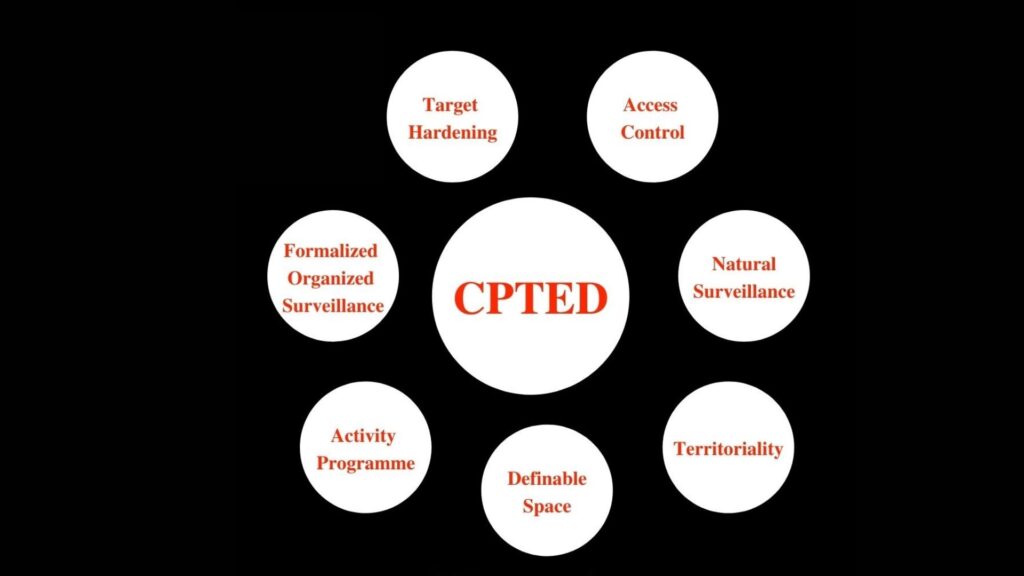Crime Prevention Through Environmental Design (CPTED)
By: Ken Shibasaki, Senior Analyst, Riskboss Inc.
So, your Board comes to you as the property manager and asks, “Should we get a CPTED analysis of our community?” What is CPTED? What are the limits of CPTED? Should CPTED be used exclusively to prevent risk in your community? Great questions. We have some answers for you.
According to Wikipedia,
“It originated in America around 1960, when urban renewal strategies were felt to be destroying the social framework needed for self-policing. Architect Oscar Newman created the concept of ‘defensible space’, developed further by criminologist C. Ray Jeffery who coined the term CPTED. Wide-ranging recommendations to architects include the planting of trees and shrubs, the elimination of escape routes, the correct use of lighting, and the encouragement of pedestrian and bicycle traffic in streets. Tests show that the application of CPTED measures overwhelmingly reduces criminal activity.”
The concept of the Broken Window Theory popularized in New York in the 1980s, assisted CPTED in the growth of this analytical model. Mayor Rudy Giuliani and Police Commissioner William Bratton used the Broken Window Theory to dramatically clean up and improve the brand image of Manhattan by the use of crime and disorder reduction strategies.
In the 1990s, the Toronto Police Service incorporated CPTED into the City of Toronto urban planning processes and procedures. City of Toronto urban planning staff routinely sent plan drawings of new developments to the Toronto Police Service, Corporate Planning Unit for opinion with respect to safety and security. Albeit, while CPTED is only one of the critical success factor analysis templates used by municipalities, it is an important one.
CPTED is based in the theory of preventative and strategic actions to deter negative behaviour and reduce risk that is nurtured through the likes of; poor lighting, blind spots, lying-in-wait building designs, improper signage, inadequate access control systems, poorly designed Closed-Circuit Television (CCTV) prevention measures, and poorly designed vehicle and pedestrian travel routes.
Designing and redesigning spaces to deter negative risk influences are key components of the CPTED philosophy. Reacting quickly to incidents of litter, graffiti, vandalism, crime, and disorder comprise the reactive components of CPTED, indicative of the Broken Window Theory (e.g. removing graffiti within twenty-four hours). Pre-planning and redesigning the urban landscape to prevent such incidents are proactive components of CPTED.
The core elements of CPTED are designed to prevent crime and disorder and also are meant to reduce the fear of crime and disorder. Redesigning urban landscapes and buildings to reduce crime and disorder creates fewer opportunities for would-be criminals to engage, deterring them from carrying out negative behaviours.
There are seven (7) main concepts at the core of CPTED:
- Access Control;
- Natural Surveillance;
- Territoriality;
- Defensible Space;
- Activity Programme;
- Formalized Organized Surveillance; and
- Target Hardening.
It should be noted that most highrise risk assessment companies use CPTED as the primary and often the only measure of analysis. CPTED is effective only within a limited scope, and only when used effectively. While CPTED does add value to the overall risk analysis, it is not the only measure that should be used and incorporated into risk assessments. CPTED alone simply doesn’t go far enough for modern comprehensive risk assessments.
Comprehensive risk assessments incorporate a wide variety of sciences and measures that include but are not limited to; emergency management, access control analysis, health and safety protocols, branding and imaging, resilient and effective governance analysis, incident management systems, GAP analysis, effective training and communication strategies, and process analysis and (re)engineering to ensure the most effective and resilient methods and best practices are utilized.
Highrise developers follow a planned methodology to ensure that they get the best possible product while maximizing efficiencies and at reduced costs. Building Code, Fire Code and Municipal planning requirements force developers to adhere to strict building standards. These building standards often have very little to do with crime and disorder prevention and risk management.
Residential communities and commercial spaces are built for people to live in and work. Striking a fine balance between target hardening and risk reduction without turning the space into what appears to be a military-like compound is the key to effective comprehensive risk assessments. Recommendations found in effective comprehensive risk assessments should not only reduce the likelihood that someone may happen, but also, make people feel safer too.
For more information about comprehensive risk assessments and to arrange a 30 minute Riskboss tour of your site with one of our senior analysts contact us at www.riskboss.com. It’s a free service we offer to introduce our services to you.
